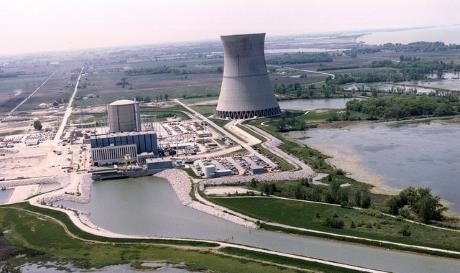FirstEnergy Corporation is advocating for Ohio to pass legislation recognising the zero-emission benefits of nuclear power, while acknowledging that it does not expect to remain the long-term owner of the state's only operating nuclear power plants. The company has confirmed it will withdraw from the competitive electricity market.
 |
| Davis-Besse (Image: Fenoc/Nuclear Regulatory Commission) |
Announcing its 2016 financial results on 21 February, FirstEnergy confirmed it plans to leave competitive operations by mid-2018, becoming a fully regulated company. This followed its announcement in November of a strategic review to investigate how it might withdraw from competitive operations.
The company reported a full-year loss of $6.2 billion, which it said reflected asset impairment and plant exit costs including charges related to the decision to withdraw from competitive operations. It recorded a $9.2 billion impairment charge for the fourth quarter, resulting from its intention to exit such operations significantly before the end of the useful lives of generation assets, including the nuclear units.
"Writing down the majority of our competitive generation assets was a necessary step towards our exit from competitive generation, regardless of which path we ultimately follow," CEO Charles Jones said in a conference call. The company was looking into several strategic alternatives for its competitive businesses, including legislative or regulatory initiatives to recognise the environmental or energy security benefits from generation as well as asset sales, plant closures, alternatives for the company's retail business and financial restructuring.
In deregulated electricity markets, such as that in Ohio, generators compete against each other to sell power to suppliers through competitive auctions. In states with deregulated markets, nuclear plant operators have faced competition from low-cost gas, particularly from shale gas developments, and subsidized wind power, leaving well-performing nuclear units - which contribute to security of supply and grid stability while avoiding carbon emissions from the use of fossil fuels - at risk of closure for economic reasons. One way of preserving nuclear capacity in such markets is explicit recognition of its benefits.
The states of New York and Illinois last year enacted measures providing so-called zero emission credits (ZEC) for non-emitters of carbon dioxide, enabling at-risk nuclear power plants to avoid premature closure. New York's Clean Energy Standard was approved by the state's public service commission in August, helping to ensure the continued operation of Exelon's Nine Mile Point and RE Ginna nuclear power plants and prompting the acquisition by Exelon of Entergy's Fitzpatrick plant, which would otherwise have faced closure in early 2017. Following the passage by state legislators of Illinois' Future Energy Jobs Bill in November, Exelon announced plans to continue operating the Clinton and Quad Cities plants - both of which had faced closure - for at least another 10 years.
Jones said FirstEnergy's "top priority" was the preservation of Ohio's two nuclear power plants, Davis-Besse and Perry. He said the company was engaging in "meaningful dialogue" with Ohio utilities and regulators on solutions that could help ensure the state's future energy security, and expected the state to introduce soon legislation for a "a zero-emission nuclear program".
Such legislation, he said, would give state lawmakers greater control and flexibility to preserve nuclear generation. "We believe this legislation would preserve not only zero emission assets but jobs, economic growth, fuel diversity, price stability and reliability, and grid security for the region," he said. "We are advocating for Ohio's support for its two nuclear plants, even though the likely outcome is that FirstEnergy won't be the long-term owner of these assets."
Bankruptcy option
FirstEnergy's 13,000 MWe of competitive generation assets, including its nuclear capacity, are owned by its FirstEnergy Solutions (FES) subsidiary. The nuclear plants - an 894 MWe pressurised water reactor (PWR) at Davis-Besse, a 1256 MWe boiling water reactor at Perry, and two PWRs totalling 1825 MWe at Beaver Valley in Pennsylvania - are operated by the FirstEnergy Nuclear Operating Company (Fenoc). Jones said the company was exploring the possibility of restructuring debt at FES and may seek bankruptcy protection for both FES and Fenoc.
Jones said FirstEnergy had been "very up-front" with Ohio legislators about its intention not to be the long-term owner of the nuclear units, but said ZECs would be important for their future. The nuclear assets are valued at around $1.5 billion, including their fuel, but their debts are "significantly higher" than that. He does not think it will be possible for the nuclear plants to become part of the company's Ohio rate-based generation, which would effectively bring them into the regulated sector, within the timeframe for FirstEnergy's exit from the competitive market.
"Absent something to raise the value of these units, and make them attractive to a buyer, there's only one way for us to exit this business," he said.
Researched and written
by World Nuclear News




_18570.jpg)
_18938.jpg)
_33584.jpg)
_82983.jpg)





